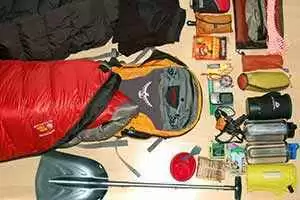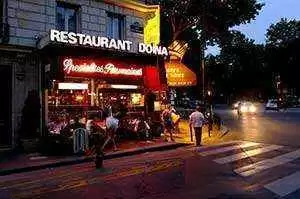Celiac.com 11/15/2007 - When I was diagnosed with celiac disease a number of years ago, I had the misfortune of being directed to the local hospital’s dietician for counseling. After she confessed that she, too, was celiac I anticipated some great tips for managing the new dietary regime. To my surprise and disappointment, she gave me less information than I had already learned from the internet between the time of diagnosis and my appointment. Then she sighed, “You’ll see. After a while, food just becomes less important to you.”
To someone who has always enjoyed good cooking and good company, that was clearly unacceptable – and it was utter nonsense. I promptly went to the bookstore, bought Rebecca Reilly’s excellent cookbook, “Gluten-free Baking,” and made a delicious gluten-free French apple tart. I put some whipped cream on the side and brought a slice to my internist, leaving it at lunchtime with thanks for a life-improving diagnosis and a suggestion not to send celiacs to that dietician. There have been too many fabulous gluten-free meals in my life since then to count.
When I retired in July, I was ready to take on new gluten-free adventures. My husband and I decided on a six week self-guided bicycle trip, variously camping and staying in inexpensive lodgings throughout southernFrance. Of course, I had to figure out how to manage celiac disease in this land of patisserie (pastry) and pain (bread). But I was determined to have a “pain-less” trip.
To cut to the chase, we had an incredible time and I ate wonderfully. We had gourmet picnics, restaurant meals, and dinners cooked on our camp stove. I only got sick once. For fellow celiacs contemplating European travel, I’d like to share here what I learned, including specific brands and general suggestions for how to get along. I do have the advantage of reasonable fluency in French, but with a little help you can manage without that.
First, I suggest you go to: Open Original Shared Link. This is the website of the “Association Francaise des Intolerants au Gluten” (French association of the gluten-intolerant). On this site, there are several particularly useful pages. One has a handy chart of foods that are “interdits” (forbidden) side by side with those that are “autorises” (allowable). I carried a print-out of this page and used it in restaurants, butcher shops, etc. I found it considerably more detailed than something like a “cuisine card” (such as the Open Original Shared Link available at Celiac.com). It shows particular types of regional sausages, for example, that are safe for celiacs, and so helped me pick out pates and cured meats after consultation with each charcutier (butcher) that I encountered. Of course, there is no substitute for being able to explain your needs and discuss a menu with the chef, but this page is a great aid. With this page and the help of a bilingual friend, I suggest you study up in advance, as well, on basic terms for wheat, rye, barley, oats, and food starch, as well as words for celiac-friendly grains such as corn (maiz), buckwheat (sarrasin), rice (riz), etc. Also, a restaurant card might be more helpful to someone who doesn't speak French than it would be for me.
Another useful afdiag.org page, if you are lucky enough to be invited into any French homes, is titled “Recevoir un Intolerant.” This gives information and advice to anyone who offers to host you. Through a biking network on the web, we had arranged contacts with a few people who gave us meals and a place to stay, and I sent them e-mails in advance politely explaining that I am gluten intolerant, and giving the link to this page.
The site also has a list of gluten-free product lines and distributors. Brand names that are exclusively gluten-free or that include some gluten-free products include not only those that are typically imported to theU.S., such as Dr. Schar, but also French and other European brands, including Valpiform, Gluta Bye, France Aglut, Barkat, and many others. By the way, the site also links to an alphabetical list by country of national gluten-intolerance organizations, which is a great resource for any traveler.
Grocery Stores
My travels were in southernFrance(the Dordogne/Lot/Vezere area, the Luberon,Provence,Carcassonne). We shopped frequently and I combed grocery stores in larger cities, includingAvignonandToulouse, smaller ones, such as Apt, and tiny villages and hill-towns for gluten-free options. In general, groceries, including the big chains such as Hyper Champion, did not seem to carry exclusively gluten-free products, such as baked goods, and I had to watch for hidden gluten in many brands, including yogurts and canned goods that, from myU.S.experience, I might have expected to be gluten-free. This was something to be cautious about in the organic food (“bio” or “biologique”) sections of regular grocery stores, too.
Rice cakes were easily available in a pinch, and instant polenta made a quick camping meal after a long day on the bikes. Both were common products even in small stores. Where buckwheat crepes are a regional specialty, you can sometimes find them, pre-packaged, in the refrigerated section of grocery stores. They were delicious filled with fromage blanc and heated on our camp stove, then topped with fresh fruit and/or one of the many fabulous jams that are available everywhere. Of course, you can find many other delicious gluten-free foods to eat at any grocery, particularly in a country that excels in cheeses, olives, fruits, vegetables, chocolate and wines. French stores also often have roasted or vacuum packed pre-cooked beets and potatoes, which make simple additions to a meal if you have no easy way to cook. And there were some serendipitous finds such as a wonderful tinned almond cake, a regional specialty of Provence (made by “L’Amandier de Ventoux” from Biscuiterie de Provence). In the town of St. Remy, the artisanal cookie bakery also made several gluten-free almond-based cookie variations that were exciting.
“Bio” Stores
But the real treasure troves are found in just about any “magasin bio.” “Bio” or “biologique” is the French term for “organic” and a “bio” is a health food store. When I inquired about products “sans gluten,” I was often told that there is increasing interest in gluten-free foods, and even the smallest “bio” stores had them. We celiacs are benefiting from a trendy idea among health-conscious consumers that gluten is suspect – and hey, let’s enjoy the sudden proliferation of choices! The bigger “bio” stores had very wide selections. There, I found packaged gluten-free muesli, cereals, muffins, small cakes, and cookies of all sorts. Some stores carried cookies from “Aux Biscuits d’Antoine,” a dedicated gluten-free French bakery; I was leery about trying their buckwheat and grapefruit flavored cookies, but they turned out to be tasty, especially with hot tea. In general, the gluten-free cookie brands ranged from numerous types that resemble good non-gluten-free European packaged cookies (filled wafers, “sandies,” etc.) to purist health food-type selections (whole grains and unprocessed sugars). While salty snacks are not as prevalent inFrance as they are in theU.S. (the French think of us as a country of between meal nibblers and over eaters), some choices are available (Barkat brand pretzels are terrific). Some snack bars were gluten-free, including an interesting if crumbly one made from chestnuts (Domino Chataigne from Grillon d’Or).
Bread
Best of all, just about every “bio” carried several types of bread, all of which were vastly better than the dense, flavorless rice breads that are the default choice in U.S. health food stores. The breads included both “white” breads (including baguettes) and whole grain options. In my pre-diagnosed life, I always preferred European type breads, so I enjoyed sampling these. There are many choices in the Schar line, including “Sunna,” which resemble whole-wheat rolls.GlutaBye,FranceAglut and Valpiform all make different varieties of “pain campagnard” (country-style bread) based on rice flour, buckwheat flour, nut flour and other ingredients. Quinoa or teff flours are sometimes included. All have a nice sour taste, like that of a good light rye, because they are based on a levain (sourdough). I used to be very fond of the dense, German-style, thinly-sliced rectangular whole rye breads, and I was thrilled to find several gluten-free versions of this type of slow baked, long shelf life bread. Pural (“Bio c’est la vie”) makes a levain based “Glutenfrieies Volkornbrot” (German whole grain gluten-free bread/ “pain complet sans gluten”) with whole rice, millet, buckwheat, lupin flour (lupin is a type of bean but, thank heaven, it does not have the bitter beany taste of garbanzo and fava bean flours), and sunflower seeds. A similar bread, also German-made, was the Bio Kerniges Buchweizenbrot (organic buckwheat bread) based on buckwheat sourdough, corn, sunflower seeds, millet, buckwheat, soy, rice, apple fibers and honey. The wide variety of languages on the labels for these products suggests that they are distributed in many European countries. [by the way, friends traveling inNorwaybrought back a box of gluten-free Wasa crackers (Knackebrod) that were phenomenal. I contacted the company but found that this particular product is made by their Swiss subsidiary and they were unaware of anyU.S.distributors.]
In two “bio” stores, I found the holy grail of gluten-free breads: freshly baked, with an excellent crumb and chewy European-style crust. These were 100% buckwheat (“pur sarrasin”) breads made by local bakers. The two stores that carried them only got them once a week and had a few loaves, which were quickly snapped up by eager customers. While I was never able to chase down the bakers, from whom I wanted to learn a few tricks of the trade, I was astounded at how good these breads were. They were nothing like the leaden buckwheat loaves that I have eaten (or rejected) in theU.S. I once bought one of these at the Flying Apron in the University district inSeattle, a bakery that has otherwise delightful gluten-free baked goods, and it became a running joke – we used it as a doorstop for a while. I brought home some levain sarrasin (buckwheat sourdough starter) fromFranceand have been experimenting in my kitchen, but have yet to get beyond the brick phase myself. Searching for recipes on the internet, to date, has not helped. Anyway, these breads are treasures to seek out.
I was, however, happy to find a German-style whole-grain gluten-free bread when I returned to the U.S. Made by “Bavarian” (which also carries a number of similar but non-gluten-free products, so be careful) this gluten-free bread has a several month shelf life and contains whole rice, whole corn, millet, and sweet lupin flour. It has a very good taste and holds together well.
If readers have other sources for gluten-free European breads in this country, please do share them. And happy travels!











Recommended Comments